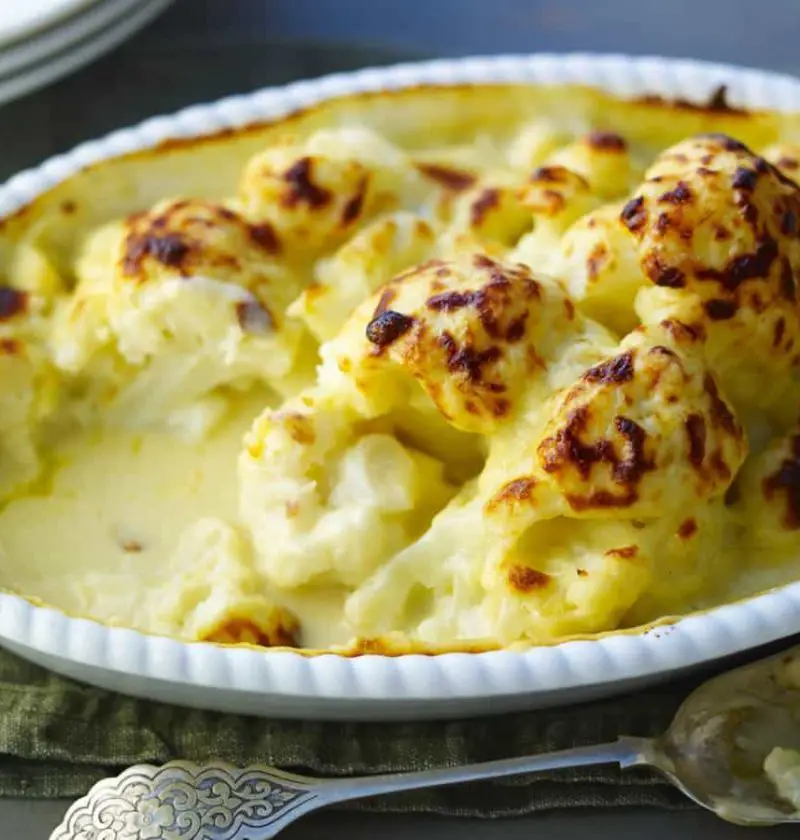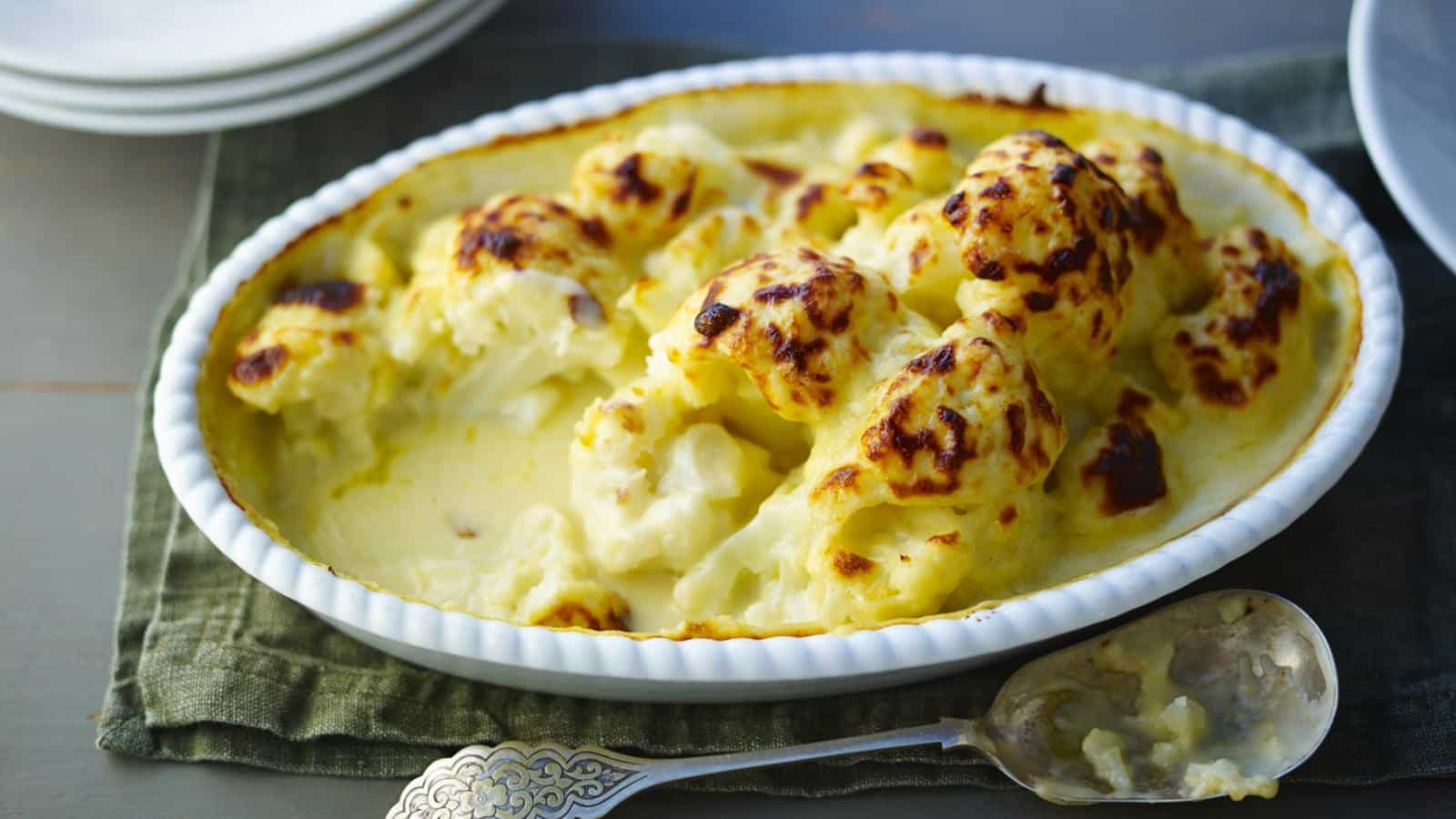
What is Mary Berry Cauliflower Cheese?
Mary Berry Cauliflower Cheese is a classic British casserole that combines tender cauliflower florets with a rich, creamy cheese sauce, baked to perfection to achieve a golden and bubbly crust.

Why You’ll Love This Recipe
- Simplicity Meets Elegance: With straightforward ingredients and easy-to-follow steps, this dish is a testament to the beauty of simple cooking.
- Comfort in Every Bite: The creamy cheese sauce and tender cauliflower create a comforting dish that warms the heart.
- Versatile: Perfect as a main for vegetarians or a side dish that complements a variety of mains.
More From Mary Berry’s
Mary Berry’s cauliflower cheese Ingredients
To make Mary Berry’s cauliflower cheese, you will need the following ingredients:
- 1 large head of cauliflower, cut into florets
- 50g (2oz) butter
- 50g (2oz) all-purpose flour
- 600ml (1 pint) milk
- 1 teaspoon mustard (Dijon or English)
- 150g (5oz) mature Cheddar cheese, grated
- 50g (2oz) Parmesan cheese, grated
- A pinch of nutmeg
- Salt and pepper, to taste
Instructions to Make Mary Berry Cauliflower Cheese
The steps are as follows:
Step 1: Prepping the Cauliflower
- Cook the Cauliflower: Begin by preheating your oven to 200°C (400°F, Gas Mark 6). Boil the cauliflower florets in salted water for 5 minutes until they’re just tender but still firm. Drain and transfer to a baking dish.
Step 2: Creating the Cheese Sauce
- Melt the Butter: In a saucepan, melt the butter over medium heat. Add the flour and stir for about 2 minutes, cooking the roux without letting it brown.
- Add the Milk: Gradually whisk in the milk, ensuring no lumps form. Cook until the sauce thickens, stirring continuously.
- Add Flavour and Cheese: Stir in the mustard, a pinch of nutmeg, and half of the Cheddar cheese. Season with salt and pepper to taste. Cook until the cheese has melted and the sauce is smooth.
Step 3: Assembling and Baking
- Combine and Bake: Pour the cheese sauce over the cauliflower in the baking dish. Sprinkle the remaining Cheddar and the Parmesan cheese on top. Bake for about 20-25 minutes, or until the top is golden and bubbly.
What Do I Serve With Mary Berry Cauliflower Cheese?
FAQs
Here are some frequently asked questions about Mary Berry’s cauliflower cheese:
What is cauliflower cheese?
Cauliflower cheese is a classic British dish that consists of cooked cauliflower florets covered in a creamy cheese sauce and baked until golden and bubbly. It can be served as a main course or as a side dish to accompany a roast or other meat dishes. It’s also a great way to use up any leftover cauliflower or cheese that you have in your fridge.
Can I make cauliflower cheese in the microwave?
Certainly! If you’re pressed for time or oven access is an issue, the microwave is a convenient alternative for making cauliflower cheese. Start by cooking the cauliflower florets in a microwave-safe dish, covered with a splash of water, for about 8-10 minutes until they’re tender. For the sauce, melt butter in another microwave-safe bowl, then gradually whisk in flour and milk until smooth. Blend in the cheese until it melts. Combine the sauce with the cauliflower and microwave for an additional 5 minutes, or until the cheese sauce is warm and velvety.
Can I make cauliflower cheese vegan?
Yes, creating a vegan version of cauliflower cheese is straightforward with the availability of plant-based substitutes. Replace dairy products with vegan butter, suitable plant milk (such as almond, soy, or oat milk), and vegan cheese. To enhance the cheesy flavor without dairy, consider adding nutritional yeast, a squeeze of lemon juice, or a dash of apple cider vinegar. These ingredients add depth and a tangy zest that mimics the traditional cheese sauce’s complexity.
Can I make cauliflower cheese gluten-free?
Indeed, making gluten-free cauliflower cheese is simple by substituting the flour used in the sauce with a gluten-free alternative. Options include cornstarch, rice flour, or almond flour, all of which work well to thicken the sauce without gluten. For a crunchy topping, consider using gluten-free breadcrumbs, crushed nuts, or seeds to add texture and flavor to the finished dish.
Can I make cauliflower cheese keto-friendly?
Final Words
Mary Berry’s cauliflower cheese is one of my favorite recipes from her cookbook collection. It’s a simple and delicious dish that is perfect for any occasion. Whether you’re looking for a quick weeknight meal or a cozy Sunday roast accompaniment, this dish will not disappoint you.
I hope you enjoyed this article and learned something new about this classic British dish. If you have any questions or comments, feel free to leave them below. I’d love to hear from you.

